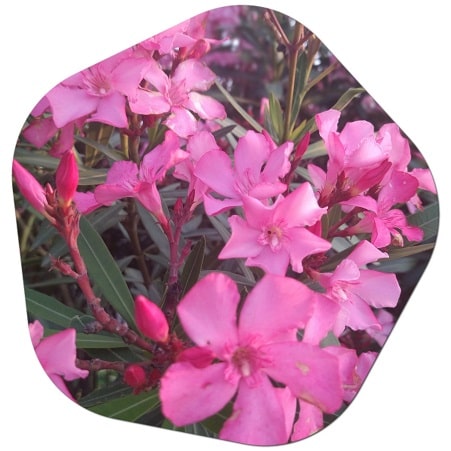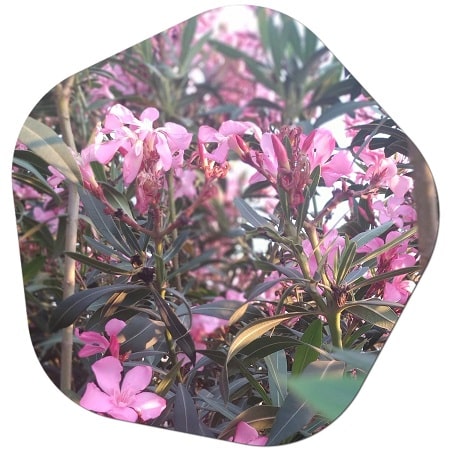The oleander plant is a shrub or shrub with blossoming flowers, the flowers of which are poisonous. California oleander plants can grow. California oleander plants are preferred as ornamental plants in landscaping areas or on roadsides in gardens. We have prepared information for you about what the oleander flower or oleander plant is used for and how it is grown in California. I hope it will be useful.
Oleander is a plant species that grows in California, oleander (Nerium oleander) is well-suited for growing in California. It thrives in the Mediterranean climate that is common in many parts of the state. Oleander is often used in California for its attractive flowers, drought tolerance, and ability to withstand the region’s warm, dry summers.
In California, oleander can be found in various settings, including:
- Landscapes and Gardens: Oleander is a popular choice for landscaping in residential, commercial, and public spaces throughout California. Its vibrant flowers, evergreen foliage, and ability to form hedges or screens make it a versatile and visually appealing option.
- Coastal Areas: Oleander is particularly well-suited for coastal regions of California, such as along the Southern California coast and in areas like San Diego, Los Angeles, and Santa Barbara. It can withstand salt spray, sandy soils, and the coastal climate.
- Highway Plantings: Oleander is commonly used for highway plantings and median strips in California. Its tolerance to drought and low maintenance requirements make it suitable for these environments.
- Parks and Public Spaces: Many parks, botanical gardens, and public spaces in California feature oleander as part of their landscaping. The vibrant flowers and lush foliage add beauty and color to these outdoor areas.

It’s important to note that while oleander is a popular choice in California, caution should be exercised due to its toxic nature. All parts of the oleander plant, including the leaves, flowers, and sap, contain toxic compounds and should be kept out of reach of children and pets. Oleander tree blossoms in California >>
What is the oleander tree used for in California?
In California, oleander (Nerium oleander) is used for various purposes. Here are some common uses of the oleander tree in California:
- Landscaping and Ornamental Purposes: Oleander is widely used in California for its aesthetic appeal in landscaping. It is valued for its beautiful, showy flowers in a range of colors, including shades of pink, red, white, and yellow. The evergreen nature of oleander, along with its dense foliage, makes it suitable for hedges, privacy screens, or as standalone ornamental trees or shrubs in gardens, parks, and residential landscapes.
- Highway and Roadside Plantings: Oleander is commonly planted along highways and roadsides in California. Its ability to tolerate a range of soil conditions, drought tolerance, and low maintenance requirements make it a popular choice for these areas. The vibrant flowers and dense foliage add visual interest and beauty to the roadside landscapes.
- Erosion Control: The deep root system of oleander helps stabilize soil and control erosion, making it useful for planting on slopes, embankments, or areas prone to erosion in California.
- Windbreaks and Privacy Screens: Due to its dense growth habit, oleander can be used as a windbreak or privacy screen in California landscapes. Planted strategically, it can provide protection from strong winds and create privacy in outdoor spaces.
It’s worth noting that while oleander is appreciated for its visual appeal and functional uses in landscaping, all parts of the oleander plant, including the leaves, flowers, and sap, contain toxic compounds. Caution should be exercised, and direct contact or ingestion of any parts of the plant should be avoided.
Always be mindful of the potential toxicity of oleander and take appropriate precautions when handling or planting it.
What is the oleander disease in California?
In California, one of the major diseases that affect oleander (Nerium oleander) is oleander leaf scorch (OLS). Oleander leaf scorch is a bacterial disease caused by the pathogen Xylella fastidiosa. It is primarily transmitted by xylem-feeding insects, such as leafhoppers, which spread the bacteria from infected plants to healthy ones.
Oleander leaf scorch is characterized by the following symptoms:
- Scorching and Browning of Leaves: The disease starts with the browning and wilting of leaf margins, progressing inward towards the leaf veins. The affected leaves often exhibit a characteristic scorched appearance.
- Leaf Drop: Infected leaves eventually drop prematurely, leading to defoliation of the plant.
- Shoot Dieback: The disease may cause dieback of branches or entire shoots, resulting in a decline in the overall health of the oleander plant.

Oleander leaf scorch is a chronic and incurable disease. Once a plant is infected, it will gradually decline over time, and there is no known cure or treatment available. Infected plants should be promptly removed and destroyed to prevent the spread of the disease to neighboring plants.
If you suspect that your oleander plants are affected by oleander leaf scorch or any other disease, it is advisable to consult with local agricultural extension services, plant pathology experts, or licensed arborists who can provide accurate diagnosis and guidance on appropriate management strategies. They can provide specific recommendations based on the local conditions and regulations in California.
How to care for the oleander plant in California?
Caring for oleander (Nerium oleander) in California requires attention to its specific needs. Here are some guidelines for caring for oleander plants in California:
- Sunlight: Oleander thrives in full sun exposure. Ensure that your oleander plant receives at least six to eight hours of direct sunlight each day. Place it in a location where it can enjoy ample sunlight.
- Watering: Oleander is a drought-tolerant plant once established, but it still requires regular watering, especially during hot and dry periods. Water deeply and thoroughly, allowing the soil to dry slightly between waterings. Avoid overwatering, as it can lead to root rot. However, during extended dry periods, provide sufficient water to prevent the plant from becoming stressed.
- Soil: Oleander prefers well-draining soil. Ensure that the soil has good drainage to prevent waterlogging, which can cause root problems. If your soil is heavy or clayey, consider amending it with organic matter or using raised beds to improve drainage.
- Fertilization: Apply a balanced slow-release fertilizer formulated for flowering shrubs or use a granular fertilizer with a ratio such as 10-10-10. Follow the manufacturer’s instructions for application rates and timing. Fertilize in early spring when new growth starts. Avoid excessive fertilization, as it can lead to excessive vegetative growth at the expense of flowering.
- Pruning: Prune your oleander plant in late winter or early spring before new growth begins. Remove dead, damaged, or diseased branches. You can also shape the plant by selectively pruning branches to maintain a desired form. Be cautious when pruning, as all parts of the oleander plant are toxic. Wear gloves and avoid contact with the sap.
- Pests and Diseases: Keep an eye out for common pests such as aphids, scale insects, and spider mites. Treat any pest infestations promptly using appropriate insecticides or insecticidal soaps. Monitor your oleander for signs of diseases like oleander leaf scorch (OLS) or fungal infections. If you notice any disease symptoms, consult with local experts for proper diagnosis and management strategies.
- Winter Protection: In areas of California where temperatures drop below freezing, consider protecting your oleander during winter. Cover the plant with frost cloth or move container-grown oleander indoors to protect it from cold temperatures.
Remember that all parts of the oleander plant, including the leaves, flowers, and sap, are toxic if ingested or if there is contact with the sap. Take precautions to keep children and pets away from the plant.
By providing proper sunlight, water, and care, you can help your oleander plant thrive in the California climate.
When do oleander tree flowers bloom in California?
Oleander (Nerium oleander) typically blooms in California from late spring to early fall. The exact timing of the flowering period can vary slightly depending on the specific climate and location within California.
In most regions of California, oleander plants start producing flower buds in late spring, typically around May or June. The flowering season then extends through the summer months, with peak bloom occurring in mid-summer, around July or August. The blooming period can continue into early fall, with some flowers persisting until September or October.
It’s important to note that the duration and intensity of the blooming period can be influenced by factors such as temperature, sunlight exposure, and individual plant health. Well-maintained oleander plants that receive ample sunlight and appropriate care are more likely to produce abundant and prolonged flowering displays.
Oleander flowers are known for their vibrant colors, including shades of pink, red, white, and yellow. They are attractive to pollinators, such as bees and butterflies, and add a splash of color to the California landscape during the summer months.
